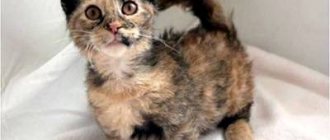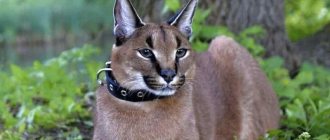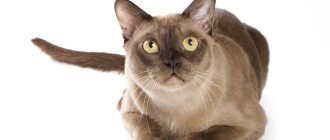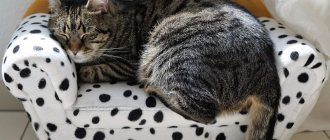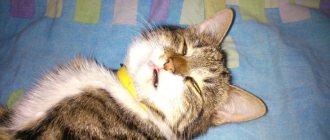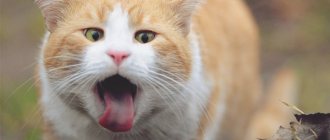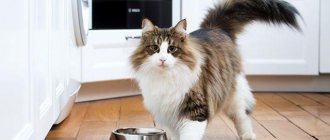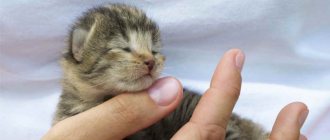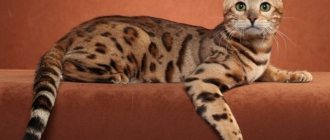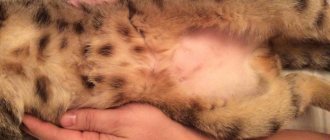Description and features
The desire to have an elf with a short tail at home is quite feasible, because this is how “pixie-bob” is translated from English. Therefore, all you need to do is turn your attention to the breed of cats with that name. Such pets make ideal companions: self-sufficient, discreet, affable, friendly and loyal.
The pixie bob boasts an original appearance, having clear similarities with the North American lynx. Actually, this is what the breed was intended to be by breeders, who painstakingly bred it with exactly these characteristics. And therefore, cats of this breed are distinguished by:
- massive body;
- strong large paws;
- short, low-set tail;
- coat marked with medium-sized and small spots;
- sideburns that complete the look of a lynx;
- in some cases, tassels on the ears.
The pixie bob's head is pear-shaped with a wide muzzle and a powerful chin. It has rounded ears at the ends, slightly tilted forward. The deep-set eyes of such cats have heavy eyelids. The color of the iris at birth is blue. But after six months it changes its color to green, brown or golden.
The nose of the representatives of the breed is brick in color, slightly humped, and wide; paw pads are dark; the tip of the tail is black or chocolate; The dark whiskers at the base may be white at the tips. According to the standards, a larger number of toes than usual is acceptable.
Pixiebobs are incomparable in size to wild lynxes; they are much smaller. As for cats, that is, the female half, even in adulthood they rarely reach a weight of more than 5 kg. But cats in this respect differ from their other brothers.
The pixie bob breed was created by crossing a forest cat with a domestic cat.
If males of other breeds, reaching the age of one year, practically stop their growth, male domestic lynxes develop and increase in size up to 4 years, and their body at the end of adulthood may well reach a ten-kilogram mass.
Kinds
looks attractive in the photo The breed itself is divided into two varieties, because its representatives come with short and long hair. However, according to standards, hair dimensions, even in special cases, should not exceed 5 cm.
Shorthaired cats have thick, straight hair. The fur on the belly is slightly longer than on other parts of the body. Its structure is fluffy and soft. In long-haired representatives of the breed, the hair lies along the body. But these are not all the differences between house elves.
The color of the pussies of this breed is characterized by brown, reddish, red, mouse tones with light tips of the hairs. Accordingly, pixie bobs come in a variety of colors. These shades are subject to seasonal changes.
Cats of this breed are distinguished by their tabby color. Its signs include: the scarab sign, that is, a dark, clear mark on the forehead in the form of the letter “M”; dark stripes on the chest, resembling necklaces in outline; rings in the form of bracelets on the tail and legs; on the lighter-colored abdomen there are rows of “medallions.”
is distinguished from the cat community by its short tail, which is most often not characteristic of its other relatives. But the representatives of the breed themselves differ from each other in their length. Their tail can measure only 5 cm, but no less. However, there is more. Sometimes, when the animal's hind leg is extended, it can reach the hock joint.
How to choose the right kitten
This is a very rare breed; if you decide to buy a kitten, it is better to do it in a specialized nursery, where, with the help of accompanying documentation, they will confirm the purebred origin of the kitten’s breed. In the nursery the pedigree will be immediately clear. There you can also find people with whom you can consult. In addition, there is always a choice and you can choose a kitten that is visually most suitable for a person.
The first step in choosing a kitten is to determine your goals. To participate in various exhibitions you need to buy a show-class kitten. Pixies of this class will exactly comply with all norms and standards.
The breed class will not become real champions due to some inconsistencies in external characteristics. But they can participate in different shows and become good producers.
The Elf kitten is weaned from its mother later than other kittens.
There is also a pet class. Cats of this class cannot participate in reproduction or exhibitions. But if this is not the main goal and you want a faithful, devoted, affectionate friend, then this is the right choice for the future owner.
Kitten care
Pixiebobab kittens are fully cared for by their mother, a cat. The change of ownership occurs no earlier than three to five months. At this time, the kitten should already be vaccinated, treated against various parasites and helminths, developed and well-fed in accordance with its age.
History of the breed
The chronicle of elf-lynxes began at the end of the 20th century in America, since it was there and then that this breed was bred. Its ancestor was a cat whose name was Pixie. And she was born from a very interesting couple: a cat with a short tail and polydactyly (more than usual number of fingers), bought in Washington, and a very large, short-tailed wild cat, rescued and selected by breeder Carol Brewer.
Pixie herself, who was soon born from such parents, had a muzzle that looked like a wild lynx and had spotted fur the color of sea sand. This cat turned out to be so interesting that Brewer soon began to implement a successful program to develop a new original breed.
Strictly speaking, experiments on crossing forest cats with domestic cats had been carried out before this point, but only in the 80s of the last century they had their worthy results. This is how the pixie bob breed , officially recognized internationally in 1995.
Pixiebob is a large breed of cat with a short tail.
Character
It is interesting that in terms of behavior and habits, representatives of this breed are more reminiscent of dogs rather than pussies. They are not at all opposed to their owner leading them on a leash during walks, while in a cat’s nature there should seem to be a desire to roam the streets without restrictions.
The fear of water is also not inherent in them, unlike those pussies who are afraid to even get their fur wet. Piskibobs do not exhibit feline selfishness and arrogant detachment; they are devoted to humans like a dog. However, they are also jealous, since they really do not like to share the attention of their patron with anyone else.
But such a desire does not reach the point of militant aggression, for the highlight of their character lies in calmness and restraint. Pussy lynxes, although descendants of wild cats, are not warlike, and therefore get along well with other animals, including the pets of the owner’s house, as well as with his children. The pixie bob cat , despite its inner equanimity, loves to jump, run and frolic.
Although he observes moderation in everything: he plays, but does not play pranks. Showing sociability, she always remembers dignity while keeping her distance. This creature will not tolerate humiliation and injustice towards its own person. Such pussies do not allow themselves to meow loudly, as ordinary cats do, but like dogs they can growl.
These creatures do not like change, and therefore it is better not to transport them from place to place unless necessary. In general, they are domestic in everything, but the free forest nature of the pixie-bob can manifest itself if it is left without attention and care for a long time, because without active contact with people it can become wild. However, reasonable intelligence is also a property of the nature of short-tailed pussies.
Such pets are characterized by good intuition, obedience, and mutual understanding with their patrons. And what’s especially nice is that they easily learn order and follow it. From everything that has been written, it is clear that the character of the pixie bob, with proper upbringing, completely allows the owners to turn the descendant of wild cats into an ideal pet, moreover, gentle and affectionate.
Nutrition
In caring for the health of little “elves”, it is not recommended to overfeed them, but rather regularly monitor the amount of food eaten. Also, when preparing for a trip before the road, you need to remember that it is better to transport such animals on an empty stomach.
Adult cats and kittens need only two meals a day on a schedule - morning and evening. The main element of the diet can be dry food, specially selected in accordance with the breed. Although the descendants of forest cats do not require any special diet, they are essentially omnivores.
But in accordance with their wild nature, they love to eat raw meat. Lynx cats often indulge themselves with such a delicacy, since they are good at catching mice. And they usually do not disdain the flesh of birds. Pixie-bob kittens also benefit from lean, raw meat.
Only it should be given crushed and added to porridge. Fish, cottage cheese, eggs, bread, and fresh herbs are also important to them. Small kittens should eat at least six times a day, but as they grow, the number of feedings decreases to three.
Pixie-bob has an affectionate, flexible character
Pixie Bob Health and Disease
The breeding program has eliminated most problems associated with inbreeding. Genetic diseases are extremely rare. Typical diseases of pixiebobs include:
- hypertrophic cardiomyopathy - the result of crossing with other breeds;
- cryptorchidism - only a few cases have been reported since 1980;
- difficult labor and cystic endometrial hyperplasia.
To keep your pet healthy, provide him with proper care and a carefully selected diet. We must not forget about timely vaccination. This will help prevent parasitic and infectious diseases.
Reproduction and lifespan
Breeding cats of this breed is far from easy. And there are several reasons for this. Firstly, the characteristics of lynx kitties play a role here: their conservatism, aversion to changing places, as well as semi-wild roots, despite their almost canine nature. This sometimes seriously prevents owners of purebred specimens from participating in exhibitions with them.
Here, beloved pets, seemingly docile and affectionate at home, can show wariness and aggression, which will not be easy to cope with. As for matings, difficulties arise in this issue again. Pixiebob genes are special. Therefore, they cannot be arbitrarily crossed with any desired breeds, but only with each other. And this makes it very difficult to choose a partner.
And most importantly, this breed of cat was bred in North America and is now mainly bred only in the USA and Canada; moreover, it is considered the national treasure of these countries, and therefore the export of such kittens to other continents is difficult. Because of this, a purebred is still considered a rarity in Russia
And the number of specimens we have does not yet allow us to create a worthy domestic population. All this makes the breed insufficiently known in our country, and therefore arouses little interest among breeders and prospective owners. Although nurseries for breeding elf-lynxes are still appearing, including in Moscow.
An interesting feature of kittens of this breed is their late maturation and formation. Therefore, for an amateur, given the rather large size of domestic lynxes, it is sometimes not difficult to mistake an immature individual for an adult. And the full life cycle of a pixie bob from birth to death is usually no more than 13 years.
Varieties
Representatives of this breed are divided into several subspecies based on color and coat length. The standard allows two types:
- semi long-haired;
- shorthaired
In the first case, the coat does not exceed 6 cm (slightly longer on the stomach). The hairs are very soft, silky and pleasant to the touch, and lie quite tightly to the body.
The coat of shorthaired Pixie Bobs is soft and fluffy, elastic, loosely fitting to the body, with an undercoat of medium length. The smooth, dense coat of this type is considered a fault. For all cats, excessively long fur on the belly and a collar on the neck are unacceptable.
Care and maintenance
The first thing that free lynx elves need is long walks, that is, sufficient movement and fresh air. This is the first thing owners of pixiebobs should think about. After all, for the healthy development of pets, you can’t just take them outside for five to ten minutes and calm down.
The call of wild ancestors, despite the innate intelligence, still makes itself felt. Therefore, from the very first days of a special cat’s stay in the house, the owner needs to devote a lot of time to its upbringing, accustoming it to the rules of the house and its requirements. But the health of pixiebobs and their immunity, as a rule, do not cause concern.
Such animals are not afraid of the cold and feel great at any time of the year. A pet's claws can become a big problem for the owner, as they can ruin carpets and furniture in the house. Therefore, for a pixie-bob, cutting them is very desirable. True, you can protect yourself from these worries by accustoming your pet to a scratching post in early childhood.
The next necessary element of care is weekly combing of the coat. This helps not only to maintain a pleasant appearance, but also prevents unwanted large amounts of hair from entering the animal’s esophagus.
Brushing your teeth, ears, and monthly bathing are also important. The latter usually does not cause big problems. Lynx cats not only love water, but they themselves often want to swim when they see any body of water.
Price
Purchasing a purebred kitten of this breed, of course, is best done in a professional, trustworthy nursery. There you can get not only the relevant documents: pedigree, veterinary passport, but also valuable advice on keeping a short-tailed “forest elf” and its proper home education. If the kitten has a wet nose, clean eyes and ears, a cheerful appearance, and is well-fed, then most likely it is healthy.
The price of a pixie bob is usually less than $15,000. If it is lower, then most likely it is not a purebred representative of the breed. And the actual cost directly depends on the kitten’s compliance with standards, its pedigree and gender. Purchasing a breed-class pet will cost much more than the stated price.
Owner reviews of pixibob
We did some digging on the Internet and collected for you reviews from real owners about animals of this breed. Perhaps they will help you decide whether to buy a pixie bob kitten or take a closer look at other breeds.
Ivan, 34 years old: “My sister gave me a cat when she got a daily job. Neither she nor the poor abandoned animal could stand the new schedule. I had to come to terms with it, not to throw it out onto the street... By occupation, I’m a freelancer, and that’s what my dear Olga appealed to, handing me a wild-looking cat. But as it turned out later, his appearance was deceptive - the cat Arkhip immediately showed sincere friendliness, becoming for me a kind of house elf (which I dreamed of after reading various fantasy stories). Plus, it requires almost no maintenance. I devote almost all my free time to my pet, we watch movies together, play, talk... Eh, I regret one thing: if only he could cook... The best cat for a bachelor is a pixie-bob - I recommend it!”
Natasha, 22 years old: “My favorite cat Ada is a pixie-bob. Soon after her quiet appearance in our house, she created a living hell in it. That’s why I called her this name, derived from the word “hell.” Naturally, I'm exaggerating a little and I'm not angry with her at all. It was even fun, and even now we don’t get bored: the kitty continues to “delight” us with her tricks. She is growing up (she is already 4 years old), but she does not lose her childish spontaneity and playfulness. And it's just great! Sometimes, of course, you want to “kick her” hard, because she rushes around the rooms at breakneck speed, demolishing everything in her path, and even howls periodically, “getting high” from her own madness. But how much I love this “crazy thing” about her; no other cat after Ada will suit me now. It’s fun and great to be with her, and when I’m sad, she lies down next to me, looks into my eyes and understands everything... Kisa listens to me as no one in the world could listen to me. If you get a pixie-bob, you will never regret it, these are the best friends in the world, as loyal as dogs!”
As you can see, pixiebob receives very emotional and enthusiastic reviews. After reading them, you just want to get a sympathetic furry friend. Do not agree? Try re-reading it.
Pixiebob
Interesting Facts
- The number of toes on the paws of the most ordinary cat is limited to eighteen: there are five on the front legs, and four on the hind legs. But pixiebobs are unusual pussies, also because they are the only breed in the world in which multi-fingeredness (polydactyly) is not at all considered a deformity or deviation, but the most common norm. It's completely acceptable. And this is documented in the breed standards. Charming purebred “wood elves” can have from five to seven fingers on each of their paws.
- The descendants of wild cats can only surprise their owners with their health. But a predisposition to some of the diseases was still revealed. In particular, among them are hypertrophic cardiomyopathy, that is, heart problems, as well as ailments in the reproductive system. The risk of being exposed to such a scourge in pixiebobs is so serious that it is recommended that they undergo an ultrasound every year. This is a preventive measure that helps to identify unwanted signs in cats in a timely manner.
- It has already been mentioned that our short-tailed elves do not like change. However, it is curious that their conservatism goes so far that they show dissatisfaction even with minor changes. For example, they may not really like the new hair color of their beloved housewife or the wallpaper in the room that has been re-pasted.
- The pride of lynx kitties are the cute tassels on their ears. But they do not grow in all representatives of the breed, but only in some. Therefore, owners of cats with such a typical lynx decoration can be considered very lucky.
- Pixiebob is not only the name of the original cat breed. This is also a fashionable short haircut for women. Moreover, its name has nothing to do with pussies. And the hairstyle was invented and brought into life by Irene Castle, a foxtrot performer. The dancer decided that it was much more convenient for her to perform her dances with short hair, so she cut her hair in a special way. Now there is a pixie-bob with bangs , and not only with regular, neat ones, but also with asymmetrical, graduated ones. Sometimes the haircut has a slightly different design, standing out in the face area with elongated strands.
Pros and cons of the breed
Appearances can be deceiving
Before getting a pet, you should study the pros and cons of this breed.
Pros of pixiebobs:
- The appearance is very similar to a lynx.
- Devotion.
- Good to train, similar to dogs.
- Good-natured and peaceful, open, non-aggressive.
- Quiet, don't meow too much.
- Care does not require much effort.
- They don't like strangers.
- They love to play and have fun.
- Walks easily on a leash.
- Curious and affectionate.
Pixiebobs are easy to train.
Disadvantages of the breed:
- They do not like changes down to the smallest details.
- Very jealous.
- They steal the owner's things.
- Rare and expensive cats.
